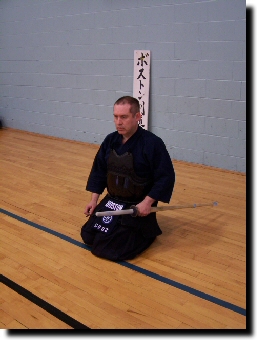 Chapter 1: Reiho - Etiquette
Chapter 1: Reiho - EtiquetteBeginner's Guide to Kendo
 Chapter 1: Reiho - Etiquette
Chapter 1: Reiho - Etiquette
It is important that you learn about the manners and etiquette of kendo. This attendance to tradition, along with kendo kata, is what differentiates kendo from sport. You should bow (ritsu rei) before entering and upon leaving the dojo. You should avoid joking and horsing around inside the dojo; always assume a serious attitude and treat the dojo as a place where something important transpires. Line up quickly and quietly when the senior student (sempai) calls the dojo to line up (sei retsu). Check to make sure you are aligned with the person to your right holding your shinai in your left hand.



Seiza
 Seiza is the traditional Japanese seated position. It is often difficult for non-Japanese to be able to sit in this manner right away. Seiza developed in Japanese culture in the context of the Japanese house wihich doesn't have chairs or couches. People sat on the floor, or more accurately on tatami mats that covered the floor. Kendo maintains this tradition. At the beginning and end of all kendo practice all dojo members wil sit in seiza to put on their bogu, bow in, and take off their bogu.
Seiza is the traditional Japanese seated position. It is often difficult for non-Japanese to be able to sit in this manner right away. Seiza developed in Japanese culture in the context of the Japanese house wihich doesn't have chairs or couches. People sat on the floor, or more accurately on tatami mats that covered the floor. Kendo maintains this tradition. At the beginning and end of all kendo practice all dojo members wil sit in seiza to put on their bogu, bow in, and take off their bogu.






After lining up wait until sempai instructs you to be seated (seiza). Sit down gently, under control, and avoid plopping the the floor with a thud. Assume the seiza position by stepping back with your left foot and lowering your left knee to the floor. Bring your right foot back and under, next to your left. Slowly lower your body until your buttocks are resting on your heels. Make sure your knees are about one or two fists apart. This may be the first test of the difficult nature of kendo. Also, try not to let your shinai crash to the floor, but rather place it there gently. Check to make sure you are still aligned to the person to your right, knees and shinai in straight lines from sempai to most junior student (kohai).


Mokuso
Sempai will then call the dojo to attention (ki o tsuke). Sit up straight, chin pulled slightly in, mouth closed. Place your hands in your lap palms up with your fingertips overlapping and your thumbs touching tip to tip. The feeling should be that you are holding an egg in your hands. If you press too hard the egg breaks; if you do not press the egg falls to the floor. Sempai will then call the dojo to engage in a moment of meditation (mokuso) to clear the mind of distractions and prepare for practice. Breath naturally through your nose, using your abdomen and diaphragm to draw the air into the bottom of your lungs. After a while, sempai will call an end to the meditation (yame).






Za rei
At this point sempai will instruct the dojo to face the shinzen, the head of the dojo, and bow (shinzen ni rei). Turn to face the front of the dojo and bow (rei) at the waist placing first your left hand and then your right on the floor in front of you. Your fingers should be extended and joined with your forefingers and thumbs touching, forming a triangle. Keep your back straight and avoid raising your hips. Do not duck your head; keep your neck in alignment with your back. After a short pause, raise yourself back to the seiza position, retracting first your right hand and then your left. Place your hands comfortably on your thighs. Sempai will then instruct the dojo to face the teachers (sensei ni rei). Turn to the teachers and follow the same method described above. However, shout in a respectful tone "onegai shimasu". This lets the teacher know that you are eager and ready to practice kendo.